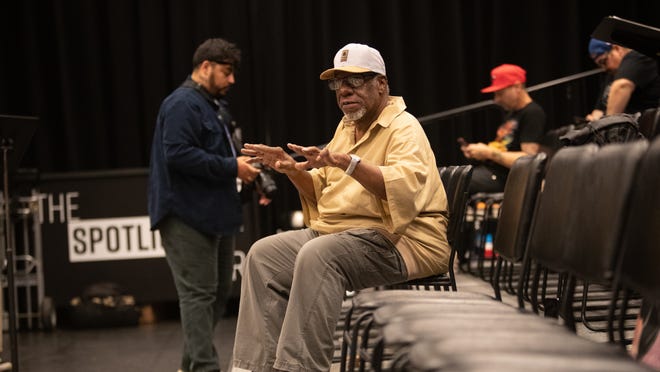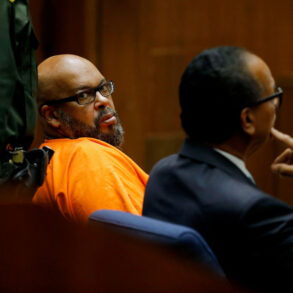When J. Edson “House” Magaña moved to Phoenix in 1990 he was 17, alone and hoping for a fresh start away from the gang violence engulfing his Chicago neighborhood.
He hated Phoenix at first. All he saw was a barren desert landscape where people were “still parking their horses at Circle K.” He was so desperate to find some “hip-hop heads” like his friends in Chicago that he strung a can of spray paint on a shoelace and wore it as a necklace, hoping it would call to other graffiti writers.
Although the only attention the paint got him was from the police, he eventually connected with other people who understood hip-hop. In 1993, he and two pairs of brothers from the Maryvale neighborhood of Phoenix established Furious Styles Crew.
They didn’t know it at the time, but their crew would go on to define the hip hop scene in Arizona. They’d compete in battles around the world, open chapters in Spain and Denmark and host a celebration of their anniversary in 1996 and every year after.
“House and Furious Styles Crew put hip-hop on the map,” said Sofia “Pinky” Magaña, House’s younger sister. “Especially here in Arizona, it was just very unheard of.”
Need a break? Play the USA TODAY Daily Crossword Puzzle.
Now, Magaña and Furious Styles are collaborating with the Herberger Theater Center in Phoenix to produce a play about Magaña’s life, culminating in the founding of the crew. The play, titled “93 Til’ Infinity: Furious Styles: A Journey of Brotherhood, Beats and Dreams,” will be presented on select days from June 17 to 27.
Hip-hop is “just all of us looking for ourselves”
Edson Magaña was born in Mexico City. When he was a baby, his family moved to Chicago.
They took frequent trips back to Mexico. One year, his family returned to Chicago after the school year had started, only to find that Magaña had lost his spot at a prestigious magnet school with a long waitlist.
He transferred to his neighborhood elementary school. On his first day of school, he walked into the classroom to find a group of boys breaking, the dance style of hip-hop.
“They were doing like this eight-man centipede worm thing,” Magaña said. “I’m like, ‘These kids are weird! They listen to some crazy music.’”
Soon after that introduction, Magaña saw a breaking performance in his local park, and he was hooked.
He also began to notice roofs painted with graffiti when he accompanied his mom downtown to pick up the jewelry that she sold. He realized the common thread between the graffiti and breaking: hip-hop culture, which also traditionally includes DJ’ing and rapping.
“The way we’ll see it is through music and art and the DJs, and that’s how it manifests. But what is it really? It’s just all of us looking for ourselves,” he said.
Going on midnight graffiti missions was thrilling and let him express himself artistically. But as he got older, it became harder to avoid the violence that he saw around him. One day soon after he graduated from high school, he woke up and knew he needed to leave Chicago.
“I was getting invited to do drive-bys at people,” he said. “I was like, OK, this is getting a little bit too violent.”
Ever since their car broke down in Arizona while they were on vacation, Magaña’s parents had been telling him what a great place it was.
So in 1990, when he was 17, he moved here alone and started community college. His father, younger sister and younger brother joined him a few years later, while his mom stayed in Chicago to work.
He immediately tried to recreate his graffiti crew from Chicago, called Chicago’s Most Wanted. But he quickly realized that didn’t make sense because people in Phoenix didn’t relate to Chicago like he did.
He eventually settled upon Styles Upon Styles, a lyric from a song by A Tribe Called Quest.
Magaña met John and Mike Rincon, brothers who went to Maryvale High School and were graffiti artists. He found out that they could also dance, and Furious Styles Crew, originally supposed to be the breaking division of Styles Upon Styles, was born.
Another pair of brothers — Mike and Adam Cruz — joined, along with Magaña’s younger brother, Odin “Odin Rock” Magaña.
“That’s why the foundation of Furious Styles Crew is really family oriented, because we were literally all brothers looking out for each other,” Magaña said.
Furious Styles would go around and battle, an organic, spontaneous exchange of dance moves that could happen anywhere — on the street, in the club or at a community center. Often, he said, a battle would start with a simple, meaningful glance.
“Another crew would walk in,” he said. “You knew and the DJ knew. You’d just give him a look. And he’d be like ‘OK,’ and he would put on the music that was the catalyst for this kind of thing.”
As Furious Styles’ reputation grew, some dancers told Magaña they would practice just to beat them.
Sofia Magaña is seven years younger than her brother and a narrator in the play. Around 2000, when she was 20, she started her own all-female dance crew called Bgirlology. She remembers watching the slow growth of hip-hop in Phoenix.
“It just started snowballing,” she said. “Furious Styles started getting a lot of rivals and that just created the battle scene here in Arizona.”
Furious Styles, all grown up
Furious Styles celebrated its 30th anniversary in 2023. Now that the crew is getting older, the focus is on paving the way for the next generation of hip-hop artists. They hope to bring hip-hop into spaces it has been historically excluded from, said DJ Akshen, who has DJ’ed for the crew for decades.
In May, for example, Furious Styles performed at the Phoenix Symphony in a show that combined classical music with the rap of Tupac Shakur and the Notorious B.I.G.
For that performance, they featured another, newer crew called DeadEnd Family.
“They’re brand new, but we’ve already put in the work,” Magaña said. “They see like, OK, we do have a place in these spaces because in the past, it’s like we don’t belong here.”
The upcoming play at the Herberger is a continuation of these efforts to bring hip-hop to new audiences. But members of Furious Styles also want to keep the focus on where hip hop came from originally.
“It was brought from nothing. Black and brown people in marginalized communities created something out of nothing,” Akshen said. “A couple years ago, who would have thought hip hop would have been in the Herberger?”
How hip-hop came to the Herberger
Rod Ambrose is an actor and director who has been in theater for over fifty years. In 1999, he won a lifetime achievement award from the city of Phoenix. The list of luminaries he has met includes Martin Luther King Jr., Angela Davis and Luis Valdez, regarded as the father of Chicano theater.
He first met Magaña in the early 2000s at Thunderbirds Teen Center in north Phoenix, where Ambrose was a program coordinator, working with first-generation kids and students who had been suspended.
One day, he heard screaming and yelling from the multipurpose room. He thought the kids were fighting, so he went to break it up.
“They weren’t fighting. They were all huddled around this character in the middle of the floor,” Ambrose said. “And he was spinning on his head!”
Magaña had recently been hired to teach breakdancing to at-risk youths at the center. He and Ambrose started talking and immediately connected.
Ambrose, like Magaña, is from Chicago and came to Phoenix to escape gang warfare. Both had become involved in art young — Ambrose was one of the original members of Black Theatre Troupe in 1970. And both, Ambrose recalled, chuckling, were short, which sometimes made life difficult.
“I understood exactly where he came from,” Ambrose said.
After Magaña stopped working at the youth center, the two didn’t see each other for 20 years. But Ambrose had made a deep impression on Magaña. He thought about him often.
That’s why, last year, when Cescily Wiener of Herberger Theater approached Magaña about making a play of his life story, saying she had the perfect person to direct it, he immediately knew who she was talking about.
“I got goosebumps immediately,” Magaña said. “I already knew she was going to say Rod Ambrose.”
Wiener, who is the director of community engagement at the Herberger, had the idea last May after hosting the Furious Styles Crew at Herberger’s First Friday Live series of outdoor performances.
She was so touched by Magaña’s story that she asked him if she could turn it into a play. He hesitantly agreed. Thus began months of conversations on the phone with Ambrose so he could write the script.
What to expect at the Furious Styles Crew play
The cast is made up of around 20 people connected to Furious Styles Crew, whether official members or not. The second part of the play involves an actual battle, with DJ Akshen spinning tracks for the dancers.
The play is for everyone — those familiar with hip-hop and those completely new to it. The cast sees it as a special opportunity to showcase the history and cultural context of hip-hop, something they say is lost in mainstream presentations of the genre.
“It’s the culture. It’s not just rap music that you hear on the radio,” Akshen said. “Rap is something you do. Hip-hop is something you live.”
Magaña said he hopes the performance will humanize graffiti artists, breakdancers, rappers and DJs. More than simply his own story, he wants the audience to understand the communities that he has been a part of, and, ultimately, invite them in.
“There’s this place for all of us weirdos to be at,” he said. “You can come and just be yourself.”
Thirty years later, Magaña has created a space that his 17-year-old self, walking around with a can of spray paint on his neck, would be proud of.
Furious Styles Crew on stage
What: “93 Til’ Infinity: Furious Styles: A Journey of Brotherhood, Beats and Dreams,” a play presenting the origin story of Phoenix hip-hop group Furious Styles Crew. It’s part of the Herberger Theater Center’s Lunchtime Theater season.
When: The premiere is at 7 p.m. Monday, June 17. Subsequent performances are at 12:10 p.m. Tuesday, Wednesdays and Thursdays, June 18-27. The play is 50 minutes long.
Where: On the Kax Stage at Herberger Theater Center, 222 E. Monroe St., Phoenix.
Admission: $10. Box lunches — a selection of sandwiches and salads — are available for $12.
Details: 602-252-8497, tickets at herbergertheater.org.
This post was originally published on this site be sure to check out more of their content.








